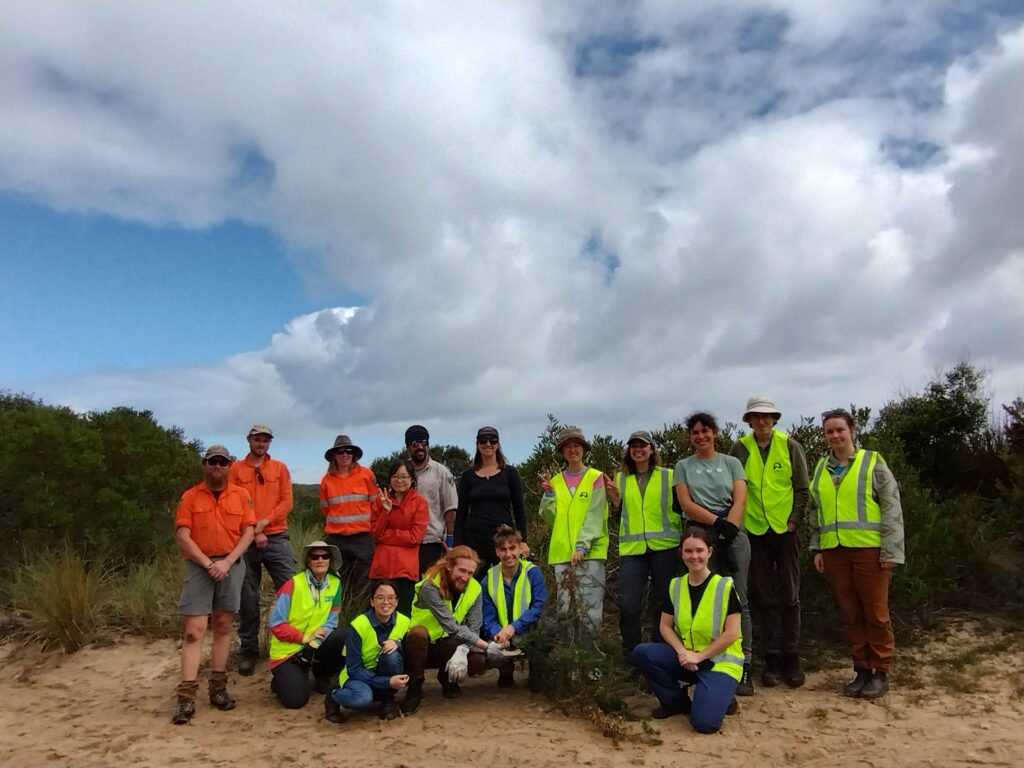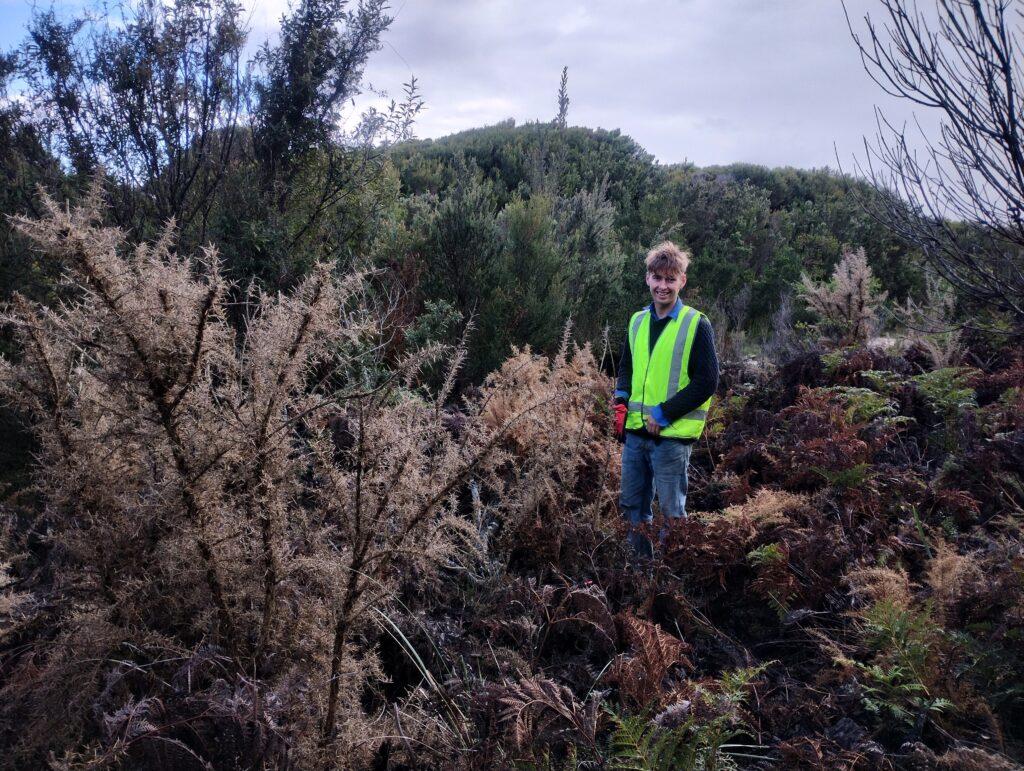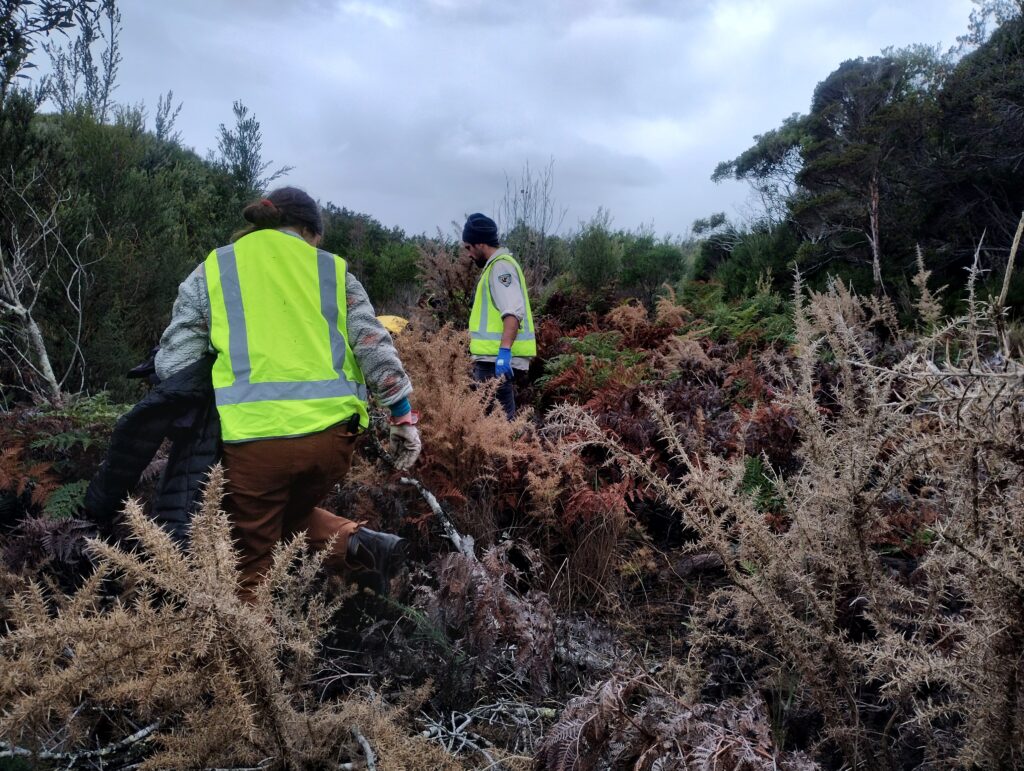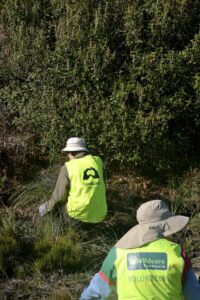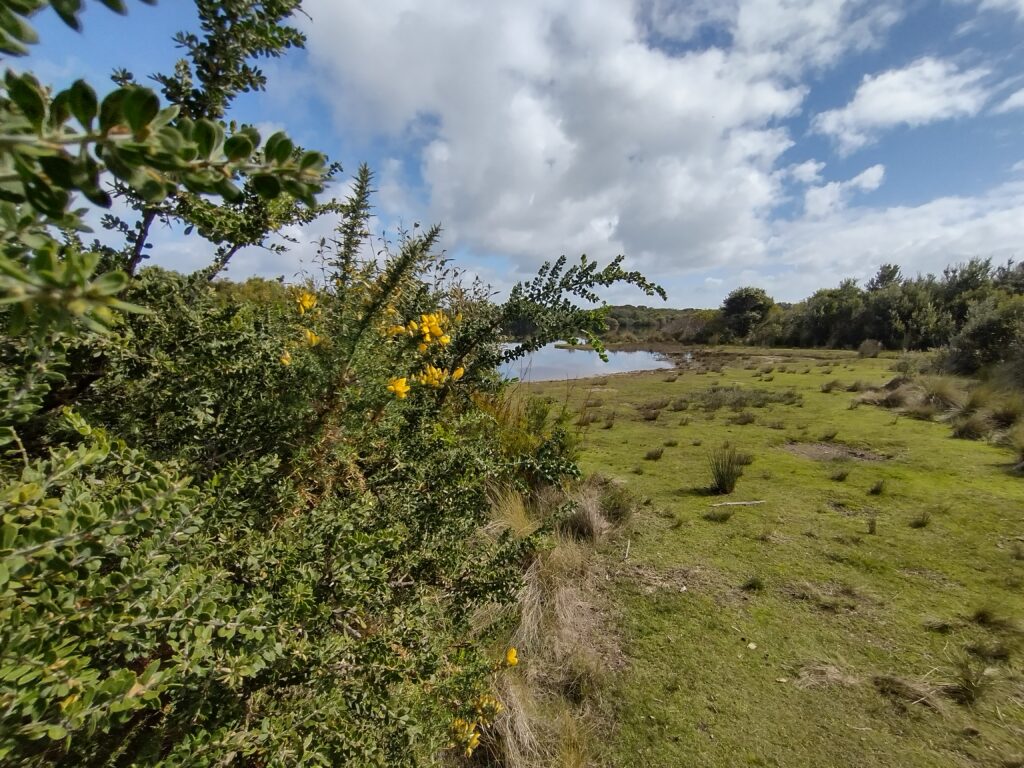Friends of the Henty’s Gorse-Busting Weekend
People are often shocked when I tell them that gorse and broom are the main weeds that our Strahan based group ‘Friends of the Henty’ deal with. It seems that it is the perception of many that the West Coast is pristine, immune to plagues of the weeds that are prevalent in agricultural land and dry bushland throughout the midlands and East Coast. But the combination of low-growing wet forest, buttongrass plains, and wet heathland almost perfectly matches the native habitats of gorse and broom in Europe. There is plenty of rain, and the soil around Strahan is acidic, nutrient poor, and either very sandy, or waterlogged peat. With just a bit of disturbance, such as the building of a track or road, the dormant gorse and broom seeds have the last ingredient they need – sunlight! Once the plants get going in these disturbed micro-sites, they can quickly grow taller than surrounding native vegetation, especially in the buttongrass plains and heathland where the tallest native plants are less than a metre high. Then the real action begins, as they shade out the native vegetation, and create more land area in which their seeds can germinate.
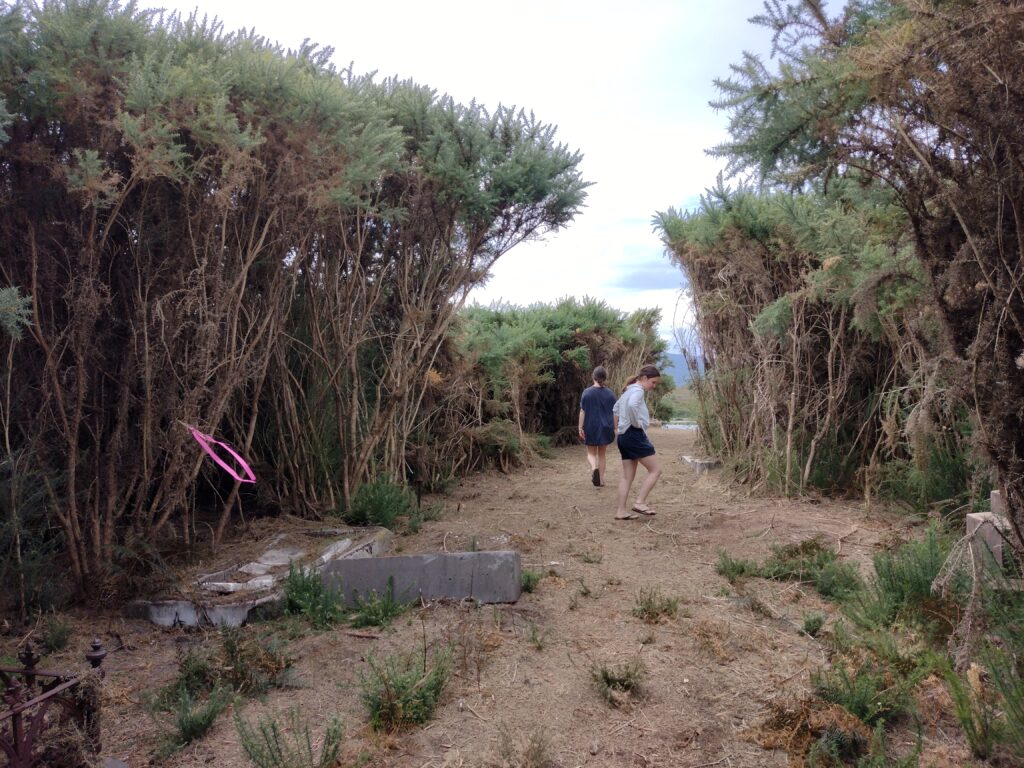
An example of how high the Gorse gets along Henty Road, north of Henty River. This is in the Zeehan pioneer graveyard.
Near the mouth of the Henty River there are a number of 4WD tracks, some campsites, and some private properties. The area has been inhabited by Europeans since the late 1800’s, and some of the tracks have been present since then. Originally the tracks were used by miners who needed to cross the Henty River as they traveled between Macquarie Harbour and the early tin mines at Heemskirk. In the 1890’s there was a small building near the mouth, occupied by a ferryman named Osborne and his family. Travelers would catch a ride across the river with Osborne, sometimes staying a night with the family. The Henty mouth area went on to become a decent sized small town into the early 1900’s due to a small-scale forestry industry. At its peak, the town had a school with over 20 students, and a functioning sawmill. Also at this time, the river was a popular tourist destination for Strahan and Zeehan residents, who would catch the train to the Henty River station (later named Koyule) for picnics, and boating activities.

A map of the Henty River mouth with Land Tenure overlay. The yellow segments mark the remaining private property, and the brown marks Ocean Beach Conservation Area. We spent the day removing gorse within the red circle.
Nowadays only a handful of people live near the river, and the tracks are generally used for recreational purposes by 4WDers, and the occasional walker (mainly me) -‘though a few are still used for property access. Given the massive gorse seedload along Henty Road north of the river, it is no surprise that gorse has made its way into the tracks, and the campsites by the river. The seed has likely traveled on 4WD vehicle tyres, and by floating down the river. Naturally, the cleared areas of the campgrounds, and the banks of the river provide great environments for gorse to grow.
It is unclear exactly how long the gorse has been growing near the Henty River, but some of the plants north of the river are easily 3 metres tall. The plants that Friends of the Henty are dealing with south of the river at the campgrounds are more tame, but still very established.
Last year, the Parks and Wildlife Service went in to the campgrounds and sprayed the bulk of the mature gorse plants. Of course, this is only the first of many steps in controlling gorse, and Friends of the Henty went in later that year to remove some of the plants that weren’t sprayed. With only 3 volunteers, we made a good dent in the gorse, but we knew we needed something more if we wanted to properly tackle it.
Harriet and I started the group in 2021, not long after we moved to Strahan from Hobart. But, our eventual move back to Hobart saw us questioning the future of the group. With nobody keen to take over the committee, we decided we would keep it going, but with an all new format! 2 multi-day working bees a year, with additional hand-power reigned in by us from Hobart, and volunteers from elsewhere in the state that couldn’t join us for our regular 3-hour working bees.
The first of these multi-day working bees took place on the 1st and 2nd of April 2023. With 16 people on the ground from Hobart, Elliott and Strahan, it was our biggest turnout for a working bee we’ve had yet. On the 1st, we made a huge dent in the gorse at the Henty River mouth, catching isolated plants and lots of regrowth post spraying. On the 2nd, we pulled out many Montpellier broom plants on the Ocean Beach Trail that had grown in the few months we have been away.
The Hobart volunteers from the UTAS Landcare Society began the long journey over to Strahan on Friday morning, stopping to admire the Franklin River rainforest and a gushing Nelson Falls. They arrived in Strahan with just enough time to set up camp at our Treasurer Dianne’s house.

Getting stuck into digging, pulling and cutting and pasting gorse regrowth. Note the radiata pine in the background, most likely a seedling that has traveled down the river from plantations further upstream.
On the Saturday, the UTAS Landcare volunteers met with PWS and Friends of the Henty volunteers from Strahan (and 1 from Elliott). We had a briefing on the day’s plan and carpooled out to the 4WD track that leads to the Henty River mouth. One group set off on foot to scour the track for lone gorse plants, while the rest of us drove in PWS vehicles to the mouth, trying not to bonk our heads on the car windows as we went over the numerous bumps and troughs. We immediately got stuck into some gorse regrowth in a big clear area. We used a mixture of techniques, including pulling (with good gloves), cutting and pasting, and even some sawing. The setting was the perfect place to work, with the scenic Henty River heading off into the distance, and lots of nice western coastal scrub vegetation surrounding us. With 16 people on the ground we made quick work of it all, easily taking out thousands of gorse plants between us all.
We broke up the day with some tea breaks, and a BBQ lunch provided by Parks and Wildlife. The UTAS volunteers celebrated a day of good work with a cold swim at West Strahan Beach and a viewing of the longest running play in Australia, The Ship That Never Was, and a dinner provided by Gordon River Cruises (NRMA).
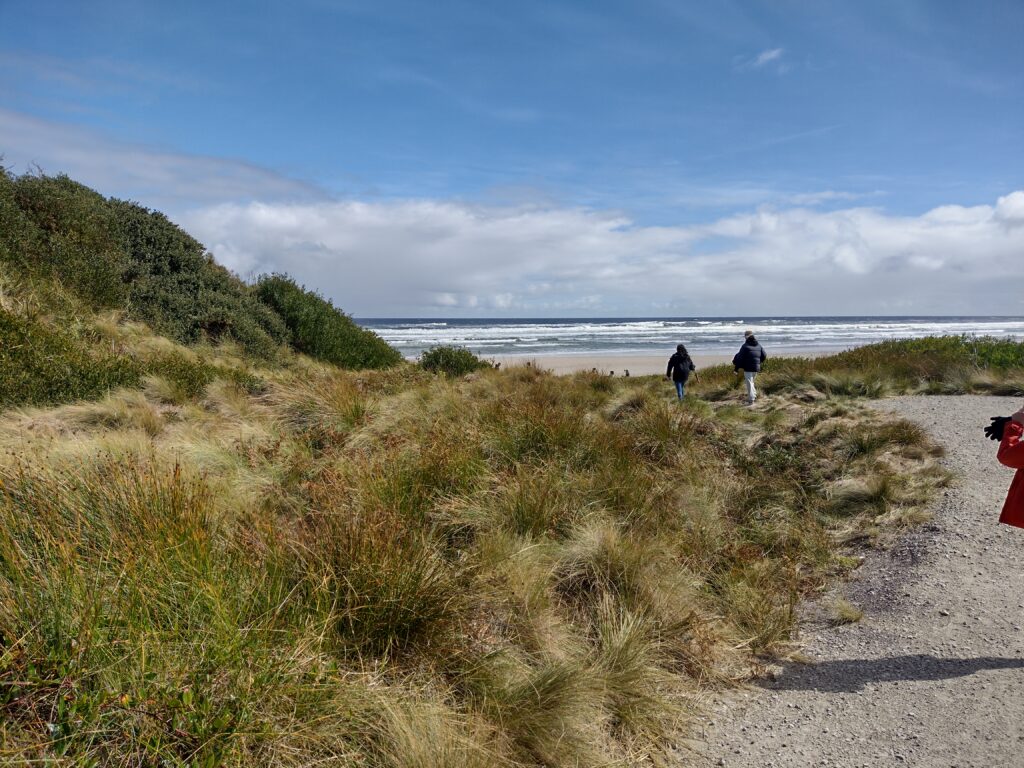
The end of the Ocean Beach Trail, coming out on to Ocean Beach. Just beyond the frame are extensive coastal grasslands, where the Montpellier broom likes to hide.
Sunday saw us tackling our old friend; the invasive Montpellier broom. We spent Sunday morning on the Ocean Beach Trail, doing some trail maintenance as well as pulling out broom where we found it. The track is looking great, and we are confident that most of the large broom plants are gone at this point. But, as the area around the trail used to be used as an illegal garbage dump of sorts, there is no shortage of disturbed micro sites that the broom capitalises on. We finished up at midday, and the Hobart and Elliott volunteers set off on the journey home with their appetite for weed killing satisfied.
The new format of working bee was certainly successful, and we are sticking with it for now! Though there will still be the odd sporadic working bee when Harriet and I are back in Strahan. Stay tuned for the next multi-day working bee coming up in September!
If you are visiting Strahan, it is worthwhile taking some time to visit the Henty River. At the crossing on the Henty Road, there is a pullover on the southern side where you can put in a kayak or go for a wander along the river. You can follow trails from here out to the Henty River campsites in Summer (in Winter there is an impassible creek crossing). It is about a 2 hour return walk, and passes through a diverse range of scenery and vegetation types. If you want more details, shoot us an email (our email address is below).
Thanks so much to everyone who came out and helped us on the weekend, to Landcare Tasmania for supporting the project, to the Friends of the Henty treasurer Dianne for letting us camp in her yard and take over her house, Parks and Wildlife for their help in planning, feeding us, and driving us around, to Gordon River Cruises/NRMA for providing us with dinner, and Wildcare Tasmania for assisting with getting Friends of the Henty up and going, and for their endless support and encouragement of our little group!
Written by Luke Cooper, President of Friends of the Henty. Email: friendsofthehenty@gmail.com
